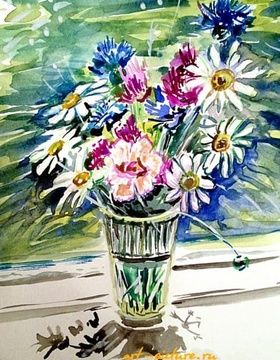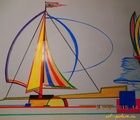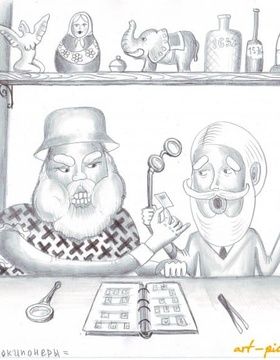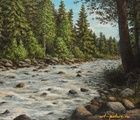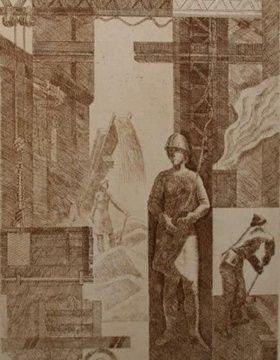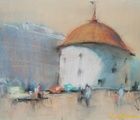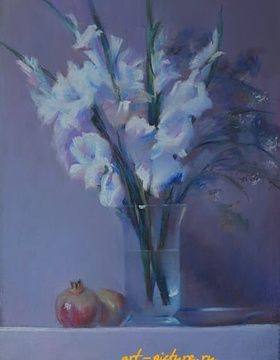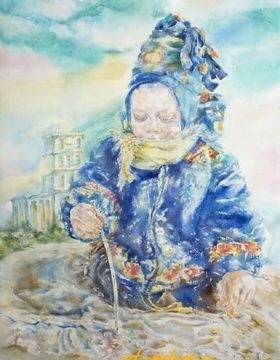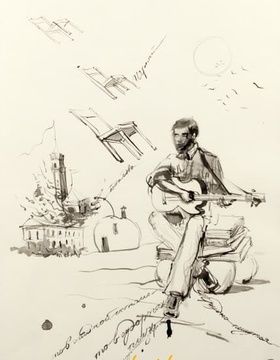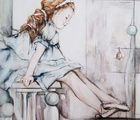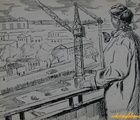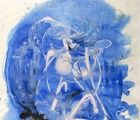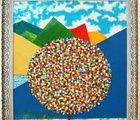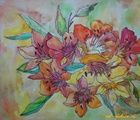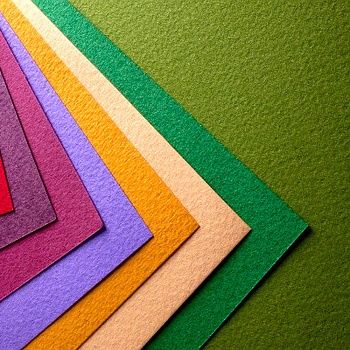
Основа для живописи - это любой физически существующий материал или поверхность, на которую наносятся краски: металл, дерево, ткань, бумага, кирпич, камень, пластик, веленевая бумага (тонкий пергамент, восковка, калька), пергамент, штукатурка, стекло. Однако лишь немногие из них представляют собой традиционные основы для масляной живописи; делятся они на две группы: эластичные (гибкие) основы, к которым относятся холст и бумага, и жесткие, объединяющие дерево, листовой фиброкартон, древесноволокнистую плиту, холст на картоне (доске) и металл.
Наиболее популярной и широко используемой основой является холст. Однако статус холста как стандартной основы для живописи относительно молод.
Древние художники предпочитали работать в энкаустике на деревянных основах, а в средние века эта практика дала толчок развитию и использованию яичной темперы на досках - первичной и важнейшей формы станковой живописи того времени. В ХV веке на начальных стадиях эволюции живопись маслом существовала как способ доработки или - завершающей стадии темперной технологии: основное внимание было по-прежнему сконцентрировано на небольших вещах с тщательной деталировкой. Такие картины фламандские художники, например, предпочитали писать маслом на грунтованных деревянных досках.
В тот период наиболее популярным материалом было дерево - дуб или береза в Северной Европе, тополь - в Италии. Металл - главным образом медь (второй по популярности материал) - использовался реже. Живопись на досках, как правило, предназначалась для коллекционеров или в качестве фрагментов декора культовой архитектуры, поэтому картины были небольшими.
В настоящее время многие художники работают на эластичных основах. Тем не менее, живопись на досках имеет своих приверженцев, и этот выбор представляет уникальные эстетические возможности. Приводим краткое описание основ, используемых сегодня в живописи маслом наиболее часто.
Льняная основа
Холст тесно связан с химией масляных красок. Льняное полотно изготавливается из волокон растения Linum usitatissimum - того самого, чьи семена применяются в производстве сырого льняного масла. Для изготовления полотна растение собирают целиком (включая и корни) в период наивысшей степени созревания, далее его оставляют для перепревания в течение трех недель. Затем из этого материала прядется прочная нить, из которой и ткется холст. Что же делает льняное полотно привлекательным? Это - его прочность и главным образом красота. По сравнению с другими тканями, льняное полотно не обладает механически правильным и ровным тканым рисунком, благодаря особенностям плетения нити. Лен всегда проступает "живой" фактурой сквозь нанесенные слои краски. Эта органичная красота наиболее четко проявляется при использовании льняного полотна стандартной и более грубых разновидностей фактуры; однако холст даже более мелкий тонкий - так называемого "портретного" качества, обнаруживает изысканную неровность и шероховатость поверхности ткани.
Важно помнить, что масляная живопись ранних периодов выполнялась тонкими слоями красок - в сравнении с более пастозной фактурой, характерной современному искусству. Краска наносилась лессировками, поэтому ее целостный слой оставался относительно прозрачным. Следовательно, фактура льняного холста становилась одним из решающих факторов, определяющих характер завершенной работы. "Неправильность" рисунка ткани и встречающиеся кое-где узелки и шероховатости наполняли лессировки искрящимся светом.
Многообразие фактур художественного льняного полотна определяется количеством нитей на дюйм. Льняной холст средней фактуры содержит приблизительно 79 нитей на дюйм; холст гладкой фактуры - так называемого "портретного" качества - содержит от 90 нитей и более. Льняное полотно может быть как одиночного (SW), так и двойного (DW) переплетения. Полотно двойного переплетения горазда прочнее, тяжелее, плотнее и, конечно же, дороже по сравнению с полотном одиночного переплетения. Оно более приемлемо для крупных живописных произведений
Хлопок
Холст ГаммаХлопчатник в качестве основы представляет собой современную альтернативу льну. Он впервые начал использоваться в художественных целях в 30-х гг. ХХ в., и с тех пор его популярность многократно возросла, особенно в США, где собственно и производиться основная его часть.
В отличие от льняного хлопчатобумажный холст не занял столь престижной позиции, мало того, он получил негативные отзывы в печати. Некоторые авторы даже сочли хлопчатобумажный холст абсолютно непригодным в качестве основы. Подобный взгляд нельзя назвать полностью справедливым, поскольку хлопок обладает определенными преимуществами. Это прочный и недорогой материал. Так же, как и лен, он имеет в структуре ту же молекулу целлюлозы. По сравнению с льняной нить хлопчатника несколько тоньше и значительно ровнее, что сказывается на фактурном рисунке ткани. Поэтому в сравнении с льняным холстом хлопок не обладает столь же интересной поверхностью. С другой стороны, ткань из хлопка более устойчива, чем лен, который имеет тенденцию к расширению и сжатию в зависимости от влажности, вызывая тем самым появление характерных "волн" вдоль границ холста. Одна из причин невысокой популярности хлопка заключается в том, что большинство имеющихся в продаже художественных хлопчатобумажных основ фактически являются слишком тонкими - в особенности те, которые натягиваются в заводских условиях. Высококачественный холст из хлопка должен быть достаточно тяжелым 340 - 430 г на квадратный метр. Хлопчатобумажный холст - соответствующим образом подготовленный, проклеенный и загрунтованный - превосходная основа для серьезной живописи маслом. "Ровная" или "правильная" фактура не является главным фактором, если краска наносится густым пастозным слоем.
Если вы хотите использовать хлопок в качестве основы для живописи, приобретайте его в художественных салонах, а не в магазинах тканей. Хлопчатобумажная материя, купленная в магазинах тканей и предназначенная, как правило, для изготовления одежды, занавесей и других предметов, обрабатывается специальными смолами, которые уменьшают образование морщинок и складок. Различные градации хлопчатобумажного полотна, предлагаемого художественными салонами - обычно называемые "cotton duck" - производятся специально для художников. Это чистый, необработанный материал; он не подвергается воздействию химикатов, которые в противном случае могут вступать в конфликт с органическим или акриловым проклеивателем.
Сложный полиэстер
Синтетическая ткань, созданная в ХХ веке, во многих отношениях превосходит как льняные, так и хлопчатобумажные холсты. Сложный полиэстер - прочный и весьма стойкий материал. Он более стабилен в отношении размеров, чем лен и менее чувствителен к кислотному воздействию масляных красок. Он не подвержен гниению, не имеет тенденции к расширению или сжатию в зависимости от влажности среды, в которой находится. На сложнополиэстерной основе могут использоваться те же грунтовки и клеевые растворы, применяемые с льняным или хлопчатобумажным полотнами. Одной из основных характеристик сложного полиэстера является полное отсутствие фактуры. Это совершенно гладкий материал. Сторонники сложного полиэстера - такие, как австралийский производитель красок Archival - настоятельно рекомендуют сложный полиэстер в качестве основы для живописи. В своей убежденности фирма не одинока; но, тем не менее, сложный полиэстер не пользуется пока особой популярностью. Да и на рынки художественных материалов он еще полностью не вышел.
Джут (мешковина)
Джут изготавливается из конопли - материала, из которого производят крепкие веревки и канаты. Холст из этого прочного натурального волокна обладает однородным тканым рисунком с ярко выраженной фактурой. Она заметно доминирует над другими элементами живописи. Это идеальная основа для работы в стиле энергичного и пастозного нанесения красок. Просветы между нитями джутового холста широкие, поэтому грунтовать его приходится иногда дважды.
Бумага
Бумага - довольно интересная мягкая основа: она разнообразна, удобна в работе и привлекательна. Бумага обладает той непосредственностью и степенью интимности, которых художники не в состоянии обнаружить у других, более привычных основ. Благодаря свойственной бумаге способности к абсорбции, краски на ней высыхают быстрее и становятся матовыми. Многообразие фактур бумаги делают ее еще более привлекательной для живописцев. Однако, как правило, бумага не рекомендуется для серьезной масляной живописи, поскольку считается не прочной. Это, безусловно, верное замечание. Но, тем не менее, работы небольших размеров не бумажной основе могут производить хорошее впечатление. Конечно, при использовании бумаги необходимо соблюдать элементарные меры предосторожности. Выбирайте только высококачественные сорта художественной бумаги. Пользуйтесь лишь 100% ветошной бумагой без содержания кислот и обращайте внимание на ее плотность. Чем плотнее будет бумага, тем лучше. Ветошный (тряпичный) картон дает наилучшие результаты. Перед живописью на бумаге или картоне, их поверхность следует загрунтовать клеевым раствором. Проклеиватель на основе животного клея, нанесенный на необработанную бумагу, надежно защитит ее от кислотности высыхающей краски. Существует и другой способ защиты: покройте бумагу слоем разбавленного акрилового средства или грунтовки gesso. Бумага абсорбирует оба грунта, а содержащиеся в ней вода вызовет деформацию бумаги и образование на ее поверхности морщинок. Для того чтобы предотвратить этот эффект, можно прикрепить края бумаги к картону клейкой лентой или степлером. Или после высыхания клеевого раствора можно смочить обратную сторону бумаги и расположить ее под несколькими листами промокаемой бумаги под грузом. Есть и третья альтернатива: покройте бумагу тонким слоем шеллака, который растворяется спиртом, и таким образом не будет подвергаться воздействию разбавителей или масла. Кроме того, существуют специальные и предварительно проклеенные виды бумаги, предназначенные в качестве основ для масляной живописи. Проклеивание - это индивидуальный процесс, он не является обязательным, если во главу угла ставится забота о прочности бумаги, поскольку эпоксидная смола предохраняет ее от гниения. Этот вид картона применим практически в любой техники - энкаустике, пастельной, акриловой, гуашевой, темперной и особенно в масляной и алкидной живописи.
Доски из древесины твердых пород
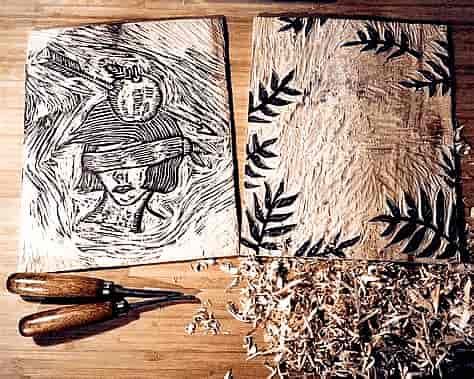
В ранние периоды развития живописи художники писали на деревянных досках-панелях. Вспомните иконы, а также магические и религиозные запрестольные образы в церквях.
Опыт работы на деревянных основах значительно отличается от опыта работы на холсте. Живопись на досках, как правило, характеризуется малым форматом и более внушительной массой, по сравнению с холстом; она, определенно, создает ощущение прочности и весомости. Практически любой вид натуральной твердой древесины может стать основной для живописи - дуб, кедр, тополь, береза, грецкий орех или, например, красное дерево (сосна - менее пригодна, так как содержит много смол и обладает слабой водостойкостью). Очень важно, чтобы дерево было зрелым (выдержанным) и не содержало влаги; на доске не должно быть трещин. Ее толщина варьироваться в пределах от 2,5 и 0,5 см, при этом толщина от 1,5 и 0,7 см считается нормой. Если доска очень тонкая, высыхающая краска непременно деформирует ее. Доска приобретет выпуклую форму - наподобие бочарной клепки. Дерево может расширяться и сокращаться. Самое уязвимое свойство древесины в том, что она имеет тенденцию к деформации вновь выровнять ее крайне сложно. Преимущество более тонких красок в том, что их деформация легче корректируется при помощи укрепления задних стенок.
К сожалению, в настоящий момент доски из твердых пород древесины являются редким и дорогим материалом; впрочем, отличной основой подобного рода могут стать повторно используемые детали мебели. Если дубовая древесина старой школьной парты или двери не сгнила и не изъедена червем, она прекрасно подойдет как основа для живописи. Потребуется лишь немного работы рубанком и наждачной бумагой, пилой - для достижения необходимого формата. Большое количество живописных произведений конца XV в. выполнялись на переработанной древесине старых парусных судов.
Фанера (многослойная доска)
Качественная фанера изготавливается из березы, красного дерева и тополя, древесина которых представляет собой гладкий и прочный материал. Одна сторона фанеры имеет грубую фактуру, а другая гладкую - эту сторону можно зачистить наждачной бумагой до превосходного состояния, подготовив ее для грунтовки клеевым раствором. Фанера обычно имеет толщину от 0,7 до 1,3 см. Если какой-либо из размеров превышает 45 см, ее, как показывает практика, следует укрепить деревянным каркасом.
Доска MASONITE (оргалит)
Это синтетический материал, изготовленный из смеси измельченных в опилки волокон древесины и клея. Смесь формируется, в результате чего образуется плоский лист. Masonite (оргалит) производится в диапазоне от темно-коричневого цвета до оттенка кофейного загара, имеет как специально обработанную (закаленную), так и необработанную поверхности. Обработанная сторона имеет значительную твердость и, возможно, перед грунтованием потребуется ее зачистка наждачной бумагой. Необработанная поверхность содержит больше волокон и характеризуется меньшей твердостью; поэтому, - из двух видов - именно такая поверхность наиболее подходит для живописи, благодаря способности абсорбировать.
Некоторые виды оргалита имеют очень гладкую, плоскую поверхность с одной стороны и напоминающую холст грубую фактуру с обратной. Но сторона с более грубой фактурой не сможет создать у зрителя впечатление, что перед ним находится ткань. Как правило, лучше пользоваться гладкой стороной. Существуют также листы оргалита, у которых обе стороны гладкие. Конечно, у этой основы отсутствует присущая дереву привлекательная фактура - текстура древесины; но ведь это свойство в любом случае будет утрачено после грунтовки доски даже из натурального дерева. Так ли уж важна природная красота древесины, если, в конечном счете, она будет скрыта под слоем грунтовки? Masonite (оргалит) имеет и свои недостатки. Первая проблема при работе с ними - доска очень легко изгибается, но не в соответствии с направлением волокон, а подчиняясь силе тяжести. Это означает, что подвешенный под углом к стене кусок оргалита станет прогибаться по направлению к центру тяжести. Для предотвращения подобного эффекта лист следует вставить в раму плотно и совершенно прямо, или поместить его плоско в лежачем положении либо усилить заднюю сторону при помощи деревянных соединительных скоб. Деформированную деревянную раму очень сложно выровнять, поэтому для укрепления задней стороны доски используйте древесину хорошего качества и солидной выдержки.
Еще одна проблема, связанная с использованием оргалита, заключается в значительном весе листов крупного размера. Если вы действительно желаете работать в крупном формате, используйте вместо оргалита многослойную фанеру, так как последняя несколько легче.
Листы оргалита недороги и продаются практически повсюду. Кроме того, они очень прочны и долговечны - срок их хранения сравним со сроком хранения твердых пород древесины; это, безусловно, очень стойка и одна из лучших доступных жестких основ художественного качества.
Металл
Художники, как правило, выбирали медь. Однако есть и другие химически устойчивые металлы - такие, как железо, нержавеющая сталь, олово (белая жесть) и алюминий. Поскольку металл - тяжелый материал, выполненные на нем живописные работы традиционно отличаются небольшим размером. В наши дни художники могут использовать легкий металлический "строительный" материал, который безупречен для работы над крупноформатными произведениями - так называемый "honeycomd aluminum" или "сотовый алюминий" (пористой структуры). "Алюминиевые соты" представляют собой два тонких листа алюминия, расположенных поверх сердцевины из волокнистого (профилированного) алюминия, напоминая, таким образом, гофрированный картон. Он производится в крупных плоских листах различной толщины, легко поддается обработке и резке.
Важнейшее качество металла заключается в его гладкой, как стекло, поверхности. Он не изгибается и не деформируется в результате воздействия высыхающей краски. Однако перед началом работы металлическую основу следует очистить от ржавчины и покрыть ее грунтовкой для металла, которая отличается от других грунтовок тем, что слегка протравливает гладкую поверхность металла и обеспечивает надежное сцепление между ней и красками. Не будь слоя грунтовки, масляные краски не смогли бы закрепиться на поверхности металла.
Металлические основы можно приобрести в магазинах металлического оборудования и художественных салонах, предлагающих различное оборудование для печати, включая пластины для гравирования.
